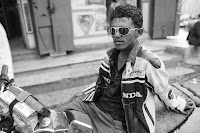
Modern Times Coffeehouse is pleased to present a new art show by local photographer James O'Gara, which will run through the month of January. For more information or to purchase prints, contact: james [at] ogaraphoto.com. All photos are © James O'Gara.
Notes from the artist:
Commonly seen as a locus of menace, the Arab ”street” is in fact neither menacing nor the monolithic location implied by the term ”street” so much as a collection of unique societies held together by little more than a common language. The photographs in this exhibit were taken over the past decade in Egypt and Yemen, two Arab countries that share remarkable histories and relative poverty.
 Yemen in particular is one of the most beautiful places imaginable for a photographer. The air is clear, the light is even and pure, and the average adult male is more distinguished looking than Alec Guinness. Yemenis are remarkably hospitable, and fairly laid back about photography, but there are limits. There will be no photographs of women, who are almost universally veiled (with the niqab: just a slit for the eyes). When a woman passes by, the proper move is to ostentatiously point one’s camera at the ground, as we all learned to do in summer camp when the archery instructor was out fiddling with the targets.
Yemen in particular is one of the most beautiful places imaginable for a photographer. The air is clear, the light is even and pure, and the average adult male is more distinguished looking than Alec Guinness. Yemenis are remarkably hospitable, and fairly laid back about photography, but there are limits. There will be no photographs of women, who are almost universally veiled (with the niqab: just a slit for the eyes). When a woman passes by, the proper move is to ostentatiously point one’s camera at the ground, as we all learned to do in summer camp when the archery instructor was out fiddling with the targets.
Other limits include a visitor being warned by a friendly Yemeni Army enlisted man not to photograph the large State Security building (known to locals as the “fingernail factory”). Similarly, a German tourist with no knowledge of Arabic is said to have been arrested for photographing an ornate Arabic graffito outside the Great Mosque that turns out to have been an obscene reference to the buttocks of a woman named Afra.

The ability to connect favors the photographer who has the time, inclination, patience, and ideally the language skills to engage with his subjects, preferably long enough that they become bored and revert to their normal way of acting and interacting. This reversion to normalcy, every bit as much as the time after sunrise and before sunset, is the photographer’s golden hour. Photographing people at work or at play dramatically speeds up this process: you can’t let yourself be distracted by some guy with a camera if you are in the backgammon fight of your life, or are this close to making a sale.
This ready intimacy can also crumble surprisingly abruptly. In Egypt, where four wars have left a degree of security consciousness verging on paranoia, the crumbling happens when a bystander shares his view that there is something suspicious about a visitor who is photographing ordinary people rather than extraordinary pyramids.
Closing in on three decades in power, the regime of Hosni Mubarak is totally out of gas. But Egypt, a slender, densely populated ribbon tracing the Nile, is nothing if not governable from the center, the opposite of Pakistan’s North and South Waziristan in every way imaginable.
Cairo’s insane overcrowding reaches its worst in the city’s Manshiet Nasr neighborhood, an old dump largely reclaimed by Christian migrant workers, and cut off from the rest of the city by a highway. The garbage workers, or zabaleen, have created a system of 16 types of trash, from paper to glass to cloth.
Eking out a living in the collapsing splendor of Cairo is no mean feat; more remarkable still is the way illiterate peasant migrants from the countryside have found steady work in sorting, cleaning, melting, and otherwise recycling garbage, all done with machinery that would cause an OSHA inspector to faint. The worst jobs, such as culling the slop for the quarter’s pigs, pay among the best, and they are jobs only the low-born would consider.
The government basically stays out of the ecosystem that is Manshiet Nasr, with rare but tragic exceptions as in 2009, when public fear of swine flu was translated into a campaign, unsupported by the science, to slaughter the city’s 350,000 pigs and pay their owners below-market rates.
Egypt and Yemen are two of the poorest countries in the Middle East, yet in neither country is life unremitting misery, as family life is strong and the calendar is punctuated by numerous religiously inspired festivals (called moulids), and these too are a subject of my photography. As Aleksandr Solzhenitsyn wrote in his Nobel Prize lecture, on art: “Ours is a world where some weep inconsolate tears and others dance to a light-hearted musical.”
Notes on the Gear
 I use a mix of 120 and 35mm film cameras and full-frame digital equipment, and output my work on an Epson large-format archival pigment inkjet printer that is the size of a stove. I shoot almost all of my subjects with a fast 28mm or 85mm lens, and most of my landscapes with a 20mm lens.
I use a mix of 120 and 35mm film cameras and full-frame digital equipment, and output my work on an Epson large-format archival pigment inkjet printer that is the size of a stove. I shoot almost all of my subjects with a fast 28mm or 85mm lens, and most of my landscapes with a 20mm lens.
The Middle Eastern sun is harsh and directional, a fine environment for black and white film but a challenge to the dynamic range limitations of digital sensors, as are the odd wavelengths thrown off at night by fluorescent light bulbs, ubiquitous in the Middle East. Much of my outdoor and night photography are therefore shot in black and white, while I typically turn to the digital sensors for low-light images and images of colorful subjects.
For more information or to purchase prints, contact: james [at] ogaraphoto.com. All photos are © James O'Gara.

 I have gotten the most questions about while at the shop is Chancha Via Circuito's Rio Arriba, a beautiful blend of South American Nueva Cancion samples, cumbia, psychedelic swirls and endless echoing electronic beats. Sounds of a decaying city-jungle dream.
I have gotten the most questions about while at the shop is Chancha Via Circuito's Rio Arriba, a beautiful blend of South American Nueva Cancion samples, cumbia, psychedelic swirls and endless echoing electronic beats. Sounds of a decaying city-jungle dream.








